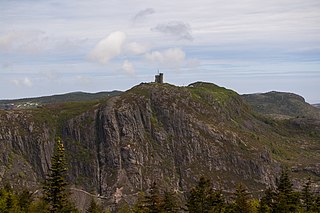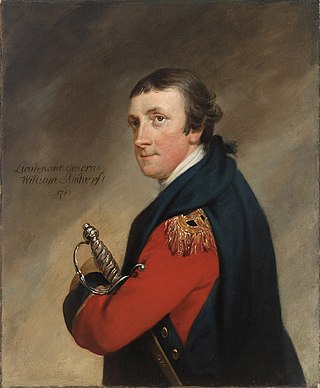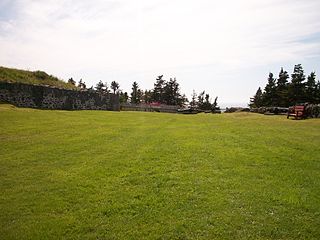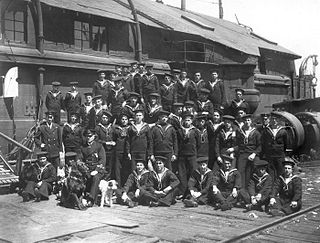
The Avalon Peninsula is a large peninsula that makes up the southeast portion of the island of Newfoundland. It is 9,220.61 square kilometres (3,560.10 sq mi) in size.

Events from the year 1762 in Canada.

Admiral Thomas Graves, 1st Baron Graves, KB was a British officer of the Royal Navy and a colonial official. He served in the Seven Years' War and the American War of Independence. He was also the Commodore-Governor of Newfoundland for a period of time.
HMS Antelope was a 50-gun fourth rate ship of the line of the Royal Navy, launched at Rotherhithe on 13 March 1703. She was rebuilt once during her career, and served in the Seven Years' War and the American Revolutionary War.

Signal Hill is a hill which overlooks the harbour and city of St. John's, Newfoundland and Labrador, Canada. The majority of Signal Hill, including Cabot Tower, is designated a National Historic Site. The highest point, Ladies' Lookout, is 167 m (548 ft) high.

St. John's International Airport is in Newfoundland and Labrador, Canada. It is located 3 nautical miles northwest of St. John's, Newfoundland and Labrador and serves the St. John's metropolitan area and the Avalon Peninsula. The airport is part of the National Airports System, and is operated by St. John's International Airport Authority Inc.

Torbay is a town located on the eastern side of the Avalon Peninsula in Newfoundland and Labrador, Canada.
Pepperrell Air Force Base, previously known as Fort Pepperrell, is a decommissioned United States military base located in St. John's, Newfoundland, Canada which operated from 1941 to 1961.
Guillaume Léonard de Bellecombe was Governor General of Réunion, Saint-Domingue and Pondichéry, and a Republican revolutionary. According to most accounts he was born in 1728 in France.

Bay Bulls is a small fishing town in the province of Newfoundland and Labrador, Canada.
HMS Shrewsbury was a 74-gun third-rate ship of the line of the Royal Navy, launched on 23 February 1758 at Deptford Dockyard.

Fort Amherst is a neighbourhood in St. John's, Newfoundland and Labrador. It is located at 47°33′48.96″N52°40′49.60″W, on the southern side of the Narrows, the entrance to St. John's harbour. Apart from some family dwellings, Fort Amherst consists of a man-made harbour, a lighthouse and the remains of gun emplacements built during World War II to defend against German U-boats. Two QF 4.7-inch B Mark IV* guns remain in place on their mountings.

Lieutenant General William Amherst was a British military commander. In 1762 during the Seven Years' War he led British forces that defeated a French expedition which had occurred earlier that year in St. John's, Newfoundland at the Battle of Signal Hill.

Charles-Henri-Louis d'Arsac, chevalier de Ternay was a French naval officer. Most active in the Seven Years' War and the War of American Independence, Ternay was the naval commander of a 1762 expedition that successfully captured St. John's Newfoundland. He was appointed commander of the Marine Royale, French naval forces, as part of the project code named Expédition Particulière that brought French troops to American soil in 1780. He died at Hunter House on Washington Street, which was headquarters for the French fleet in Newport, Rhode Island.

Castle Hill is an area containing the remains of both French and British fortifications, overlooking the town of Placentia in Newfoundland and Labrador, Canada. The site was originally established in order to protect the French fishing interests in Terre-Neuve (Newfoundland) and the approaches to the French colony of Canada.
The timeline of St. John's history shows the significant events in the history of St. John's, Newfoundland and Labrador.

The Newfoundland expedition was a series of fleet manoeuvres and amphibious landings in the coasts of Newfoundland, Labrador and Saint Pierre and Miquelon carried out by the combined French and Spanish fleets during the French Revolutionary Wars. This expedition, composed of seven ships of the line and three frigates under the orders of Rear-Admiral Richery sailed from Cadiz in August 1796 accompanied by a much stronger Spanish squadron, commanded by General Solano, which had the aim of escorting it to the coast of Newfoundland.

Fort Waldegrave was a battery or an emplacement for heavy guns in St. John’s Newfoundland, strategically overlooking the Narrows and St John’s Harbour.

Fort William was a fort in St. John's built in 1698 to protect English interests on Newfoundland, primarily against French opposition. It was the original headquarters of the British garrison in Newfoundland. A second fort, known as Fort George was situated at the east end of the harbour connected by a subterranean passage with Fort William. On the south side of the Narrows, there was a third fortification called the Castle. Garrison headquarters were later moved to Fort Townshend, which was built between 1775-1779.
General Hugh Debbieg was an English army officer, military engineer and surveyor.














